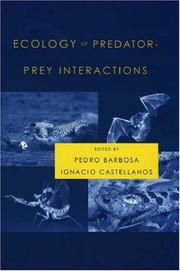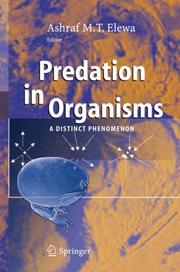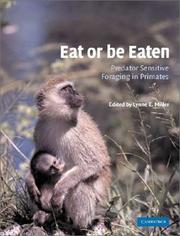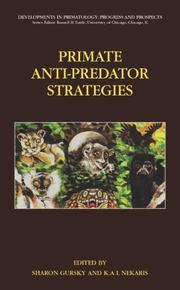| Listing 1 - 10 of 32 | << page >> |
Sort by
|

ISBN: 0309064058 9786610186228 1280186224 0309569109 0585024359 9780585024356 6610186227 9780309064057 9780309073875 0309073871 0309174651 Year: 1997 Publisher: Washington, DC : National Academy Press,
Abstract | Keywords | Export | Availability | Bookmark
 Loading...
Loading...Choose an application
- Reference Manager
- EndNote
- RefWorks (Direct export to RefWorks)
SCIENCE --- Environmental Science (see also Chemistry / Environmental) --- Wildlife management --- Gray wolf --- Bears --- Predation (Biology) --- Animal Sciences --- Agriculture --- Earth & Environmental Sciences --- Control --- Wolves --- Communities, Predator-prey --- Dynamics, Predator-prey --- Interactions, Predator-prey --- Predator-prey communities --- Predator-prey dynamics --- Predator-prey interactions --- Predator-prey relations --- Predator-prey relationships --- Predator-prey systems --- Predators and prey --- Predatory behavior (Biology) --- Predatory-prey relationships --- Prey and predators --- Prey-predator relationships --- Preying (Biology) --- Relations, Predator-prey --- Relationships, Predator-prey --- Systems, Predator-prey --- Ursidae --- Animal ecology --- Animals --- Parasitism --- Carnivora --- Canis --- Food
Book
ISBN: 1922144177 1922144169 9781922144171 Year: 2012 Publisher: Canberra ANU Press
Abstract | Keywords | Export | Availability | Bookmark
 Loading...
Loading...Choose an application
- Reference Manager
- EndNote
- RefWorks (Direct export to RefWorks)
Val Plumwood was an eminent environmental philosopher and activist who was prominent in the development of radical ecophilosophy from the early 1970s
Zoology --- Health & Biological Sciences --- Animal Behavior --- Predation (Biology) --- Mathematical models. --- Communities, Predator-prey --- Dynamics, Predator-prey --- Interactions, Predator-prey --- Predator-prey communities --- Predator-prey dynamics --- Predator-prey interactions --- Predator-prey relations --- Predator-prey relationships --- Predator-prey systems --- Predators and prey --- Predatory behavior (Biology) --- Predatory-prey relationships --- Prey and predators --- Prey-predator relationships --- Preying (Biology) --- Relations, Predator-prey --- Relationships, Predator-prey --- Systems, Predator-prey --- Animal ecology --- Animals --- Parasitism --- Food --- eco-philosophy --- eco-feminism --- Crocodile --- Dualisms --- Ecology --- Ontology --- Predation --- Veganism --- Western culture

ISBN: 1283121484 9786613121486 0199874549 9780199874545 0195171209 9780195171204 019988367X 0197700799 Year: 2023 Publisher: Oxford : Oxford University Press,
Abstract | Keywords | Export | Availability | Bookmark
 Loading...
Loading...Choose an application
- Reference Manager
- EndNote
- RefWorks (Direct export to RefWorks)
Addressing the issues of predator-prey interactions, with an emphasis on predation among arthropods, this work will appeal to ecologists interested in the broad issue of predation effects on communities.
Predation (Biology) --- Predatory animals --- Communities, Predator-prey --- Dynamics, Predator-prey --- Interactions, Predator-prey --- Predator-prey communities --- Predator-prey dynamics --- Predator-prey interactions --- Predator-prey relations --- Predator-prey relationships --- Predator-prey systems --- Predators and prey --- Predatory behavior (Biology) --- Predatory-prey relationships --- Prey and predators --- Prey-predator relationships --- Preying (Biology) --- Relations, Predator-prey --- Relationships, Predator-prey --- Systems, Predator-prey --- Animal ecology --- Animals --- Parasitism --- Ecology. --- Food --- Prédation (Biologie) --- Prédateurs --- Ecologie
Book
ISBN: 0190267909 1280595663 9786613625496 0199913846 9780199913848 9781280595660 9780199913831 0199913838 Year: 2012 Publisher: New York : Oxford University Press,
Abstract | Keywords | Export | Availability | Bookmark
 Loading...
Loading...Choose an application
- Reference Manager
- EndNote
- RefWorks (Direct export to RefWorks)
Understanding the functioning of ecosystems requires the understanding of the interactions between consumer species and their resources. How do these interactions affect the variations of population abundances? How do population abundances determine the impact of predators on their prey? The view defended in this book is that the ""null model"" that most ecologists tend to use is inappropriate because it assumes that the amount of prey consumed by each predator is insensitive to the number of conspecifics. The authors argue that the amount of prey available per predator, rather than the absolu
Predation (Biology) --- Food chains (Ecology) --- Food webs (Ecology) --- Trophic ecology --- Animals --- Ecology --- Nutrient cycles --- Communities, Predator-prey --- Dynamics, Predator-prey --- Interactions, Predator-prey --- Predator-prey communities --- Predator-prey dynamics --- Predator-prey interactions --- Predator-prey relations --- Predator-prey relationships --- Predator-prey systems --- Predators and prey --- Predatory behavior (Biology) --- Predatory-prey relationships --- Prey and predators --- Prey-predator relationships --- Preying (Biology) --- Relations, Predator-prey --- Relationships, Predator-prey --- Systems, Predator-prey --- Animal ecology --- Parasitism --- Mathematical models. --- Food
Book
Abstract | Keywords | Export | Availability | Bookmark
 Loading...
Loading...Choose an application
- Reference Manager
- EndNote
- RefWorks (Direct export to RefWorks)
This eBook is a collection of articles from a Frontiers Research Topic. Frontiers Research Topics are very popular trademarks of the Frontiers Journals Series: they are collections of at least ten articles, all centered on a particular subject. With their unique mix of varied contributions from Original Research to Review Articles, Frontiers Research Topics unify the most influential researchers, the latest key findings and historical advances in a hot research area! Find out more on how to host your own Frontiers Research Topic or contribute to one as an author by contacting the Frontiers Editorial Office: frontiersin.org/about/contact
predation risk --- predator --- prey --- defense --- fear

ISBN: 1280745398 9786610745395 3540460462 3540460446 364207961X Year: 2007 Publisher: Berlin, Heidelberg : Springer Berlin Heidelberg : Imprint: Springer,
Abstract | Keywords | Export | Availability | Bookmark
 Loading...
Loading...Choose an application
- Reference Manager
- EndNote
- RefWorks (Direct export to RefWorks)
Predation is considered one of the distinct phenomena related to the interrelationships between species on the Earth. Predation is an interaction between organisms (animals) in which one organism (predator) captures and feeds upon another (prey). Others consider predation as an interaction between two species in which one of them gains and the other loses. There are diverse predators living on the Earth, ranging in size from micro-creatures, like ostracods, to big mammals like lions and tigers. Of course, we, humans, think of these big cats as well as reptiles, like crocodiles and snakes, as typical predators. However, spiders, centipedes, most lizards and turtles, and frogs are also voracious predators. In general, predation is widespread not only in wildlife but also in marine environments where big fishes eat small fishes and other organisms of the sea. Some important questions arise to mind when discussing this subject: what is behind predation? Why some predators do not benefit from their prey after killing them? Are there genetic origins of this antagonism between organisms? Why some female organisms kill their males after completion of sex? How can we avoid predation? To answer these questions an excellent group of experts working on this phenomenon discuss the following main topics: What is behind predation in organisms? - Factors affecting predation in organisms - Predator-prey interaction - The distinct role of predation in keeping the environmental equilibrium - Examples of predation in the fossil record - Examples of predation in marine and non-marine organisms - Herbivory, carnivory, cannibalism, parasitoidism, and parasitism - Scavenging compared to predation - Future trends in this subject.
Predation (Biology) --- Animal behavior. --- Animals --- Animals, Habits and behavior of --- Behavior, Animal --- Ethology --- Animal psychology --- Zoology --- Ethologists --- Psychology, Comparative --- Communities, Predator-prey --- Dynamics, Predator-prey --- Interactions, Predator-prey --- Predator-prey communities --- Predator-prey dynamics --- Predator-prey interactions --- Predator-prey relations --- Predator-prey relationships --- Predator-prey systems --- Predators and prey --- Predatory behavior (Biology) --- Predatory-prey relationships --- Prey and predators --- Prey-predator relationships --- Preying (Biology) --- Relations, Predator-prey --- Relationships, Predator-prey --- Systems, Predator-prey --- Animal ecology --- Parasitism --- Behavior --- Food --- Animal ecology. --- Zoology. --- Aquatic biology. --- Evolution (Biology). --- Biogeosciences. --- Animal Ecology. --- Freshwater & Marine Ecology. --- Behavioral Sciences. --- Evolutionary Biology. --- Animal evolution --- Biological evolution --- Darwinism --- Evolutionary biology --- Evolutionary science --- Origin of species --- Biology --- Evolution --- Biological fitness --- Homoplasy --- Natural selection --- Phylogeny --- Hydrobiology --- Water biology --- Aquatic sciences --- Ecology --- Natural history --- Geobiology. --- Aquatic ecology . --- Behavioral sciences. --- Evolutionary biology. --- Aquatic biology --- Earth sciences --- Biosphere
Book
ISBN: 0080921051 0123741742 9780123741745 9780080921051 Year: 2009 Publisher: Amsterdam ; London : Academic,
Abstract | Keywords | Export | Availability | Bookmark
 Loading...
Loading...Choose an application
- Reference Manager
- EndNote
- RefWorks (Direct export to RefWorks)
This book is an authoritative work on the ecology of some of America's most iconic large mammals in a natural environment - and of the interplay between climate, landscape, and animals in the interior of the world's first and most famous national park.Central Yellowstone includes the range of one of the largest migratory populations of bison in North America as well as a unique elk herd that remains in the park year round. These populations live in a varied landscape with seasonal and often extreme patterns of climate and food abundance. The reintroduction of wolves into the park a de
Mammals --- Animal communities --- Predation (Biology) --- Ecosystem management --- Wildlife conservation --- Ecology --- Animal conservation --- Animals --- Conservation of wildlife --- Preservation of wildlife --- Protection of wildlife --- Species conservation --- Species preservation --- Species protection --- Wildlife preservation --- Wildlife protection --- Wildlife resources conservation --- Wildlife resources preservation --- Wildlife resources protection --- Conservation of natural resources --- Nature conservation --- Endangered species --- Wildlife management --- Biotic communities --- Ecosystems management --- Applied ecology --- Environmental management --- Biodiversity conservation --- Communities, Predator-prey --- Dynamics, Predator-prey --- Interactions, Predator-prey --- Predator-prey communities --- Predator-prey dynamics --- Predator-prey interactions --- Predator-prey relations --- Predator-prey relationships --- Predator-prey systems --- Predators and prey --- Predatory behavior (Biology) --- Predatory-prey relationships --- Prey and predators --- Prey-predator relationships --- Preying (Biology) --- Relations, Predator-prey --- Relationships, Predator-prey --- Systems, Predator-prey --- Animal ecology --- Parasitism --- Communities, Animal --- Eutheria --- Mammalia --- Mammalians --- Prototheria --- Theria --- Vertebrates --- Conservation --- Management --- Food

ISBN: 1107131065 1280955872 9786610955879 0511206364 0511351380 0511077955 0511561377 0511610238 051107638X 9780511077951 9780511351389 9780511076381 9780511610233 9780521804516 0521804515 9781280955877 0521011043 0521804515 9780521011044 9781107131064 6610955875 9780511206368 9780511561375 Year: 2002 Publisher: Cambridge : Cambridge University Press,
Abstract | Keywords | Export | Availability | Bookmark
 Loading...
Loading...Choose an application
- Reference Manager
- EndNote
- RefWorks (Direct export to RefWorks)
Predator sensitive foraging represents the strategies that animals employ to balance the need to eat against the need to avoid being eaten. Ecologists working with a wide range of taxa have developed sophisticated theoretical models of these strategies, and have produced elegant data to test them. However, only recently have primatologists begun to turn their attention to this area of research. This volume brings together primary data from a variety of primate species living in both natural habitats and experimental settings, and explores the variables that may play a role in primates' behavioural strategies. Taken together, these studies demonstrate that predator sensitive foraging is relevant to many primates, of various body sizes and group sizes and living in different environments. Eat or be Eaten encourages further discussion and investigation of the subject. It will make fascinating reading for researchers and students in primatology, ecology and animal behaviour.
Predation (Biology). --- Primates. --- Primates --- Predation (Biology) --- Mammals --- Behavior, Animal --- Behavior --- Vertebrates --- Behavior and Behavior Mechanisms --- Chordata --- Psychiatry and Psychology --- Animals --- Eukaryota --- Organisms --- Appetitive Behavior --- Zoology --- Health & Biological Sciences --- Searching Behavior --- Appetitive Behaviors --- Behavior, Appetitive --- Behavior, Searching --- Behaviors, Appetitive --- Behaviors, Searching --- Searching Behaviors --- Ceremonial Behavior --- Primate --- Communities, Predator-prey --- Dynamics, Predator-prey --- Interactions, Predator-prey --- Predator-prey communities --- Predator-prey dynamics --- Predator-prey interactions --- Predator-prey relations --- Predator-prey relationships --- Predator-prey systems --- Predators and prey --- Predatory behavior (Biology) --- Predatory-prey relationships --- Prey and predators --- Prey-predator relationships --- Preying (Biology) --- Relations, Predator-prey --- Relationships, Predator-prey --- Systems, Predator-prey --- Animal ecology --- Parasitism --- Quadrumana --- Eucarya --- Eukarya --- Eukaryotes --- Eukaryotas --- Eukaryote --- Animalia --- Animal --- Metazoa --- Chordates --- Chordate --- Behavior And Behavior Mechanism --- Vertebrate --- Acceptance Process --- Acceptance Processes --- Behaviors --- Process, Acceptance --- Processes, Acceptance --- Autotomy Animal --- Animal Behavior --- Animal Behaviors --- Ethology --- Mammalia --- Mammal --- Food --- Behavior. --- Food. --- primates --- social behaviour --- Feeding habits --- natural enemies --- Biological competition --- population dynamics

ISBN: 128090139X 9786610901395 0387348107 0387348077 1441941908 Year: 2007 Publisher: New York, NY : Springer US : Imprint: Springer,
Abstract | Keywords | Export | Availability | Bookmark
 Loading...
Loading...Choose an application
- Reference Manager
- EndNote
- RefWorks (Direct export to RefWorks)
Since the 1960s, primatologists have recognized the impact of predation on the evolution of morphology, the social systems and cognitive behavior of monkeys and apes, but few studies considered its impact on the prosimians - lemurs, lorises, galagos and tarsiers. This comprehensive volume, written by experts in the field, narrows this gap by highlighting the effect of predation on the order Primates in general. Theoretical approaches to understanding how primates perceive predation threat, as well as proximate and ultimate causes to address threat and attack, are considered across the primate order. Although this volume concentrates on the least known group in this theoretical area - the prosimians - contributions by researchers on numerous primate taxa across four major geographical regions make this a novel and exciting contribution to students interested in primate evolution and ecology.
Life sciences. --- Behavioral sciences. --- Developmental biology. --- Ecology. --- Zoology. --- Anthropology. --- Life Sciences. --- Behavioral Sciences. --- Developmental Biology. --- Human beings --- Biology --- Natural history --- Animals --- Balance of nature --- Bionomics --- Ecological processes --- Ecological science --- Ecological sciences --- Environment --- Environmental biology --- Oecology --- Environmental sciences --- Population biology --- Development (Biology) --- Growth --- Ontogeny --- Biosciences --- Sciences, Life --- Science --- Ecology --- Prosimians --- Patas monkey --- Howler monkeys --- Cercopithecus aethiops --- Chacma baboon --- Predation (Biology) --- Effect of predation on. --- Communities, Predator-prey --- Dynamics, Predator-prey --- Interactions, Predator-prey --- Predator-prey communities --- Predator-prey dynamics --- Predator-prey interactions --- Predator-prey relations --- Predator-prey relationships --- Predator-prey systems --- Predators and prey --- Predatory behavior (Biology) --- Predatory-prey relationships --- Prey and predators --- Prey-predator relationships --- Preying (Biology) --- Relations, Predator-prey --- Relationships, Predator-prey --- Systems, Predator-prey --- Animal ecology --- Parasitism --- Chaeropithecus ursinus --- Papio ursinus --- Papio --- Cercopithecus pygerythrus --- Cercopithecus sabaeus --- Cercopithecus tantalus --- Green monkey --- Grivet monkey --- Savanna monkey --- Vervet monkey --- Cercopithecus --- Erythrocebus patas --- Hussar monkey --- Red guenon --- Erythrocebus --- Alouatta --- Howling monkeys --- Atelidae --- Lower primates --- Prosimian primates --- Prosimii --- Strepsirhini --- Primates --- Food --- Animal behavior. --- Animals, Habits and behavior of --- Behavior, Animal --- Ethology --- Animal psychology --- Zoology --- Ethologists --- Psychology, Comparative --- Behavior --- Ecology . --- Primitive societies --- Social sciences
Book
ISBN: 0674425405 0674425383 9780674425385 9780674736764 9780674425408 0674736761 9780674736764 9780674425392 Year: 2015 Publisher: Cambridge, MA : Harvard University Press,
Abstract | Keywords | Export | Availability | Bookmark
 Loading...
Loading...Choose an application
- Reference Manager
- EndNote
- RefWorks (Direct export to RefWorks)
Humans domesticated dogs soon after Neanderthals began to disappear. This alliance between two predator species, Pat Shipman hypothesizes, made possible unprecedented success in hunting large Ice Age mammals—a distinct and ultimately decisive advantage for human invaders at a time when climate change made both humans and Neanderthals vulnerable.
Human beings --- Human evolution. --- Neanderthals. --- Dogs --- Human-animal relationships --- Predation (Biology) --- Communities, Predator-prey --- Dynamics, Predator-prey --- Interactions, Predator-prey --- Predator-prey communities --- Predator-prey dynamics --- Predator-prey interactions --- Predator-prey relations --- Predator-prey relationships --- Predator-prey systems --- Predators and prey --- Predatory behavior (Biology) --- Predatory-prey relationships --- Prey and predators --- Prey-predator relationships --- Preying (Biology) --- Relations, Predator-prey --- Relationships, Predator-prey --- Systems, Predator-prey --- Animal ecology --- Animals --- Parasitism --- Canis canis --- Canis domesticus --- Canis familiarus --- Canis familiarus domesticus --- Canis lupus familiaris --- Dog --- Domestic dog --- Domestic animals --- Gray wolf --- Homo mousteriensis --- Homo neanderthalensis --- Homo primogenicus --- Homo sapiens neanderthalensis --- Neandertalers --- Neandertals --- Neanderthal race --- Neanderthalers --- Fossil hominids --- Evolution (Biology) --- Physical anthropology --- Evolutionary psychology --- Human geography --- Migrations of nations --- Antiquity of human beings --- Origin of human beings --- Human evolution --- Origin. --- Migrations. --- Evolution. --- History. --- Food --- Origin --- adaptation. --- dna. --- domestication animals. --- habitat destruction. --- hominin. --- how neanderthals died out. --- human canine bond. --- hunter gatherer. --- indigenous species. --- interbreeding. --- introgression. --- mans best friend. --- paleolithic. --- pleistocene. --- sapiens. --- survival. --- weapons. --- why did humans domesticate dogs. --- woolly mammoth.
| Listing 1 - 10 of 32 | << page >> |
Sort by
|

 Search
Search Feedback
Feedback About
About Help
Help News
News